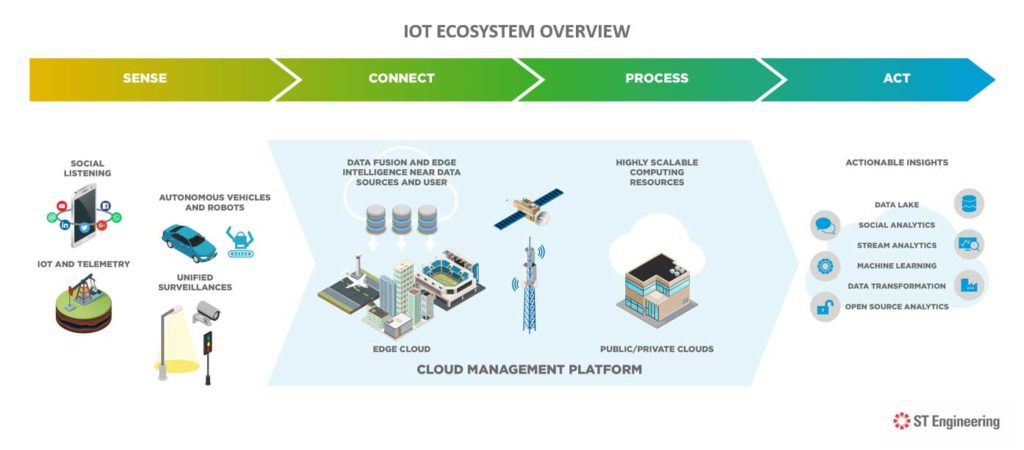By Rajesh Suseelan, Senior Director, Strategic Business Development
On Tuesday, I had the pleasure of speaking at the renowned Smallsat Symposium to set out the market opportunities for Satellite IoT or Internet of Things. The Satellite IoT market is at the forefront of innovation. During this conference, it became very clear that the entire satellite industry is embarking on a new journey, where it will form part of a much larger connectivity strategy. The industry at large is looking to make use of innovations such as 5G, virtualization, automation and orchestration to combine developments in both space and ground segment. A major application driving that change is IoT and the need to use satellite to connect everything and provide ubiquitous coverage.
Terrestrial connectivity has many limitations, and this is leading to an increase in adoption of satellite IoT across a myriad of markets. For example, its anywhere, anytime capability enables real-time asset management through tracking of vehicles or means that fleet operators can monitor the conditions of their assets.
At industry sites, IoT sensors collect data in the field, measure air and water quality and track weather and environmental circumstances.
With respect to smart energy, IoT gives insight into the generation and transmission of electricity. It enables asset management for mining and construction companies.
Agriculture raises a number of different use cases for IoT, whether it is tracking of cattle or proactive monitoring of the environment and conditions. The bottom line is the improvement of output, creating greater yield and reducing inputs such as water and fertilizers whilst optimizing and automating equipment and assets on the farm.
In maritime, the monitoring, control and surveillance of fishing vessels helps to sustainably manage fish stocks, marine reserves, as well as protect the livelihoods of fisherfolk. There are significant use cases for IoT in vessel performance management and optimization.
The biggest benefit that all of these different applications have in common is the process and productivity improvements that come with the implementation of an effective IoT strategy.
It is important to highlight the challenges
There are a number of different challenges that we’re facing with global IoT connectivity at the moment. Obviously, with terrestrial connectivity the first one is availability. Connectivity is not ubiquitous and it’s not available where you need it and when you need it.
Cost is another factor. Traditionally, satellite IoT connectivity has always come at a premium compared to the terrestrial options, which has limited its adoption in many use cases. In many cases, provisioning of off-grid power to support the various communication and sensor subsystems adds additional costs.
Then, there’s interoperability. Proprietary protocols and interfaces increase integration and support costs. How do you ensure that any connectivity option that you deploy is able to retrieve data from the endpoints easily and your application at the other end is able to analyze and process that data using industry standard protocols and APIs?
The final challenge is deployment. This encompasses a number of different factors, like ease of installation and ease of management. This is especially important since these devices are often deployed in very remote locations.
With the advent of new innovations in the space and ground segment, many of these hurdles are being knocked down and we are seeing disruptive solutions transforming IoT connectivity.
So, what does it take to be successful in the Satellite IoT market?
In connectivity cases, emphasis is placed on affordable, ultra-reliable, low latency connectivity systems with greater transparency and ease of operations.
The success of today’s organizations and service providers lies with networks that are easy to plan, install and operate, yet provide affordable connections made possible by highly efficient, small and very inexpensive satellite terminals with quick deployment for fast revenue generation and OPEX reduction.
At ST Engineering iDirect, we believe success in the IoT market at large lies in a robust ecosystem of partners and the ability to deliver specific applications for targeted use cases. It’s about technology alliances and working together to best address the challenges we’ve talked about in this blog. And it’s about offering cost-effective connectivity solutions that take advantage of the advances in the satellite industry when it comes to new constellations, smaller, more cost-effective satellite terminals and very efficient transmission technologies.
ST Engineering iDirect has launched flexible IoT solutions built on these advances to supplement our highly successful platforms. We ease the entry of service providers into the IoT market by reducing the upfront capital investments and operational complexity usually required to launch an IoT platform and service. Our IoT offering provides customers with a complete connectivity solution for fixed and mobile IoT environments.
Ultimately, IoT is about delivering business value and making a positive impact on the end user’s bottom line – and that is what we are here to support.
For further information about our offering, please visit our IoT page.

